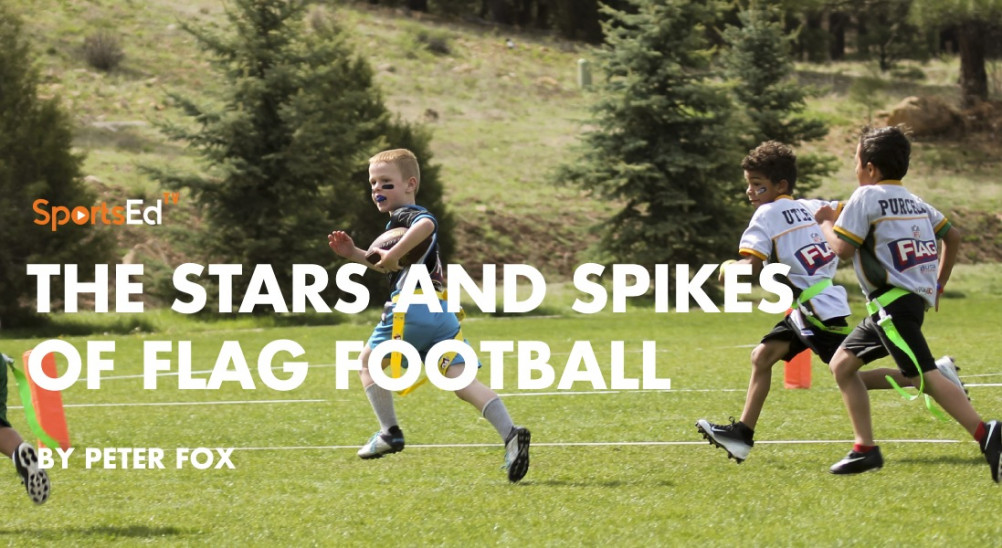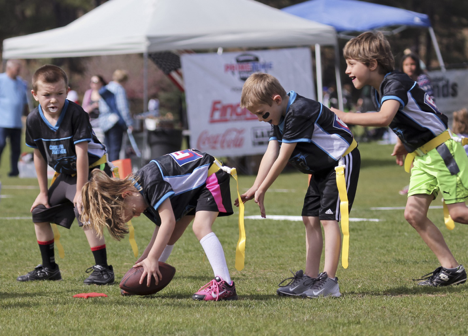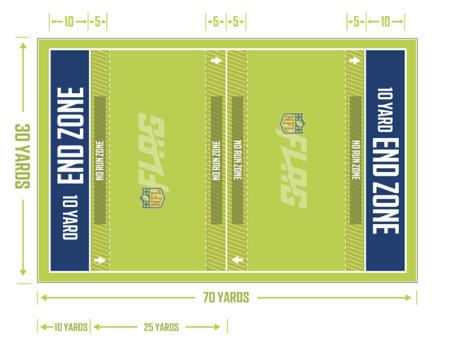Football - American
Welcome and thanks for visiting...

The Stars and Spikes of Flag Football

The Stars and Spikes of Flag Football
The adrenalin-pumping joy of touchdowns has reached critical mass.
Just ask the millions of flag football players who practice end zone spiking in preparation for the thousands of weekly games they play on real and makeshift gridirons everywhere.
As a safer alternative to full-contact tackle football, the flag iteration of the game fathered by Yale University's Walter Camp in 1880 traces its origins to World War II when the game was played on military installations.
Undoubtedly safety is a primary mover in all forms of football, flag, tackle, and touch, and given the recent notoriety and research on concussions in all sports, we’d be remiss if we did not point readers to SportsEdTV’s Concussion discussion.
Today Flag Football, not unlike other sports, comes in many shapes, sizes, sexes, ages, and locations as recreational and even professional leagues incite its growth.
Simply, players wear a belt with three removable cloth strips which are attached by either a Velcro or clip attachment. When a cloth strip is removed in action it is equal to a tackle and play stops.

The National Football League and American Flag Football League play prominent roles in promoting the game as the most recent spurt in popularity has developed a complicated system of rules and regulations, specific to individual organizations.
In most cases, the rules follow these basic tenets:
- The first rule of flag is there’s no contact allowed. That includes tackling, diving, blocking, and screening. Instead, players wear flags that hang along their sides by a belt. To “tackle” the person in possession of the ball, the opposing team needs to pull one or both of their flags off.
- All passes must be forward and received beyond the line of scrimmage
- Only direct handoffs are permitted—there are no laterals or pitches anywhere on the field
- The quarterback has a seven-second pass clock to get rid of the ball
- The quarterback can’t run with the ball unless it was handed off first
- Offensive players must steer clear of the rusher and may not get in his/her way
- Any defensive player lined up seven yards off the line of scrimmage is eligible to rush
- If the ball is handed off, any defender may rush
- Interceptions are returnable (even on extra-point attempts)
- The ball is dead when it hits the ground, the offensive player’s flag is pulled from their belt, the ball-carrier steps out of bounds, or the ball-carrier’s body—outside of their hands or feet—touches the ground
- All offensive flag football penalties result in a loss of down and yardage
- All defensive flag football penalties result in an automatic first down and some are associated with yardage
Readers thinking about participation are advised to check rules with the specific entity which governs organized play in their chosen league.
NFL FLAG is the official flag football league of the NFL and the largest flag football organization in the U.S. with 1600 teams, half a million athletes in 50 states. The NFL Flag Tournament Rule Book is here.
Another strong supporter of flag football is SportsEdTV’s partner i9Sports which notes, “flag football’s popularity continues to grow each year as more boys and girls discover the fun and excitement of the game. Parents love the game because it offers a safer alternative to tackle football.”
Needing nothing more than a ball, somes cones, and the belt with strips, getting started in flag football is very easy.
Flagging the Growth
The safety, expense, and size of 11 on-a-side full contact tackling football have been barriers to recreational play, encouraging flag football growth, said to be growing at a 23% rate in a recent participation report by the Sports Fitness Industry Association.
Like its counterparts—baseball and basketball—the adaptation of football to recreational populations was again influenced by factors allowing athletes to access the enjoyment of playing the sport by adapting workarounds to physical, equipment, and facility limitations.
Flag football teams compete 5 on 5, but you may find various leagues out there—6 on 6, 7 on 7, 9 on 9—depending on the region and age group. The size of the field they play on will vary, too. Here is a look at a typical field, courtesy of NFL Flag.

To play, usually a game begins with a coin toss to determine which team gets the ball first. There is no kickoff. Teams compete for two 15 to 25-minute halves, depending on which league governs play. The clock only stops for timeouts, injuries, and half-time.
To begin play and after opposing touchdowns the team with the ball starts on its 5-yard line and has four plays to cross midfield for a first down.
If the offense fails to advance after three tries, they have two options: they can "punt," which means they turn the ball over to the opposing team who starts its drive from its 5-yard line, or they can go for it and turn over the ball from that spot if they fail to cross midfield.
If the offensive team crosses midfield, they have three downs to score a touchdown.
Evolution
It only took 50 years for Abner Doubleday’s 1839 Cricket evolution to baseball to morph into softball or mushball as it was originally called in 1839.
Thirty years after that Princeton and Rutgers played a game that combined rules of rugby and soccer which 11 years later Walter Camp developed into the tackle football we recognize today.
An interesting artifact at the Walter Camp Foundation is a letter to him from a teacher at an Indiana school—James Kivlan—asking him for advice on how to start a football team. Kivlan was an assistant professor at Notre Dame.
Though historians place non-contact football origins to late 19th century games, the version known as flag football continues to be popularly traced to the military in the mid-20th Century.
Fort Meade, Maryland annually commemorates its claim as the World War II vintage birthplace of flag football with an annual Army-Navy game at its Mullins field.
Flag Football for All
Beginning football enjoyment by playing flag football has a significant track record. Tom Brady, Payton, and Eli Manning began their stellar careers on flag football teams.
As a kid, Drew Brees played too and has taken his relationship with flag football to even greater heights. As a co-founder of Football ‘N America, he relishes his role as a parent, coach.
“Football ‘N America is a non-contact youth co-ed flag football league for children in grades K-10. Our leagues provide a safe, positive, competitive, and family-friendly environment to learn the game the right way and have fun doing it,” Brees says.
See more about Drew Brees and his involvement in flag football here
Going Pro
Perhaps Flag Football's coming-of-age milestone is the formation of professional play replete with CBS Sports TV contracts, and big names like Michael Vick and Danny Weurfeel competing for big dollar tournament prizes.

The American Flag Football League calls itself the preeminent professional flag football league in the United States, saying it’s a collective of elite athletes hailing from a variety of sports who have the speed, agility, and charisma to compete and entertain on a national stage.
The AFFL announced its new Women’s Division will consist of 8 teams and will compete for a $200,000 Grand Prize—the same amount for both the Men’s and Women’s Champions, leading the movement to level the playing field for gender pay equality in sports.
Full Circle Amenities
As football spun into flag football, influenced primarily by safety will we soon see organic tailgating?





